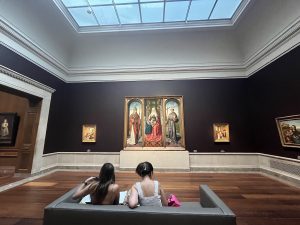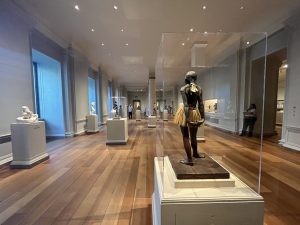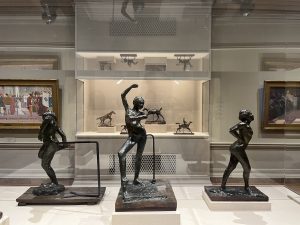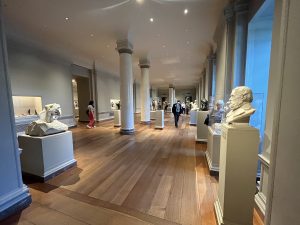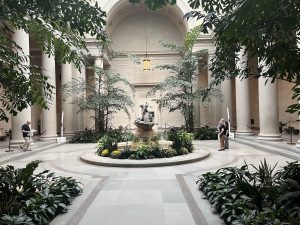But trust me, to discover the sprawling, green canvas of the US capital that is a blend of Victorian, Georgian and Regency architecture and quite unlike the skyscraper-packed American cities, you need this open bus tour.
So as a first thing before you explore the free Smithsonian museums or take a picture outside the White House or be amazed by the tree-lined Washington neighborhoods like Georgetown with architecturally appealing Victorian row houses and townhouses, experience an average tourist thing.
Hop on to this bus (Big Bus Tours) for a Washington DC bus tour to get that scratching-the-surface introduction to the city’s iconic landmarks from the top deck. And remember, you can always hop on and off. It does not inhibit your freedom to choose. I did exactly that.
I actually ended up spending most of my time at the Lincoln Memorial overlooking the grand vista of the National Mall.
Lincoln Memorial and a walk to National Mall
So I hopped off at the Lincoln Memorial entry point. What followed that late afternoon to evening is a relaxed experience of loafing about while exploring. So here you are at the memorial to Abraham Lincoln, who was assassinated on April 14, 1865, just as the Civil War was ending.
According to the National Park Service (NPS), which administers the memorial and the National Mall zone at large, by March of 1867, Congress incorporated the Lincoln Monument Association to build a memorial to the slain 16th president.
The Lincoln Memorial is about the statue of Lincoln, murals, and inscriptions. NPS says the ground was broken for the foundation of the memorial on February 12, 1914.
“All foundation work was completed in May 1915. Earlier that year work had started on the main structure itself and fill was brought in to build up the circular mound that would be the landscape setting for the memorial. Work continued at a steady pace until April 1917, when the United States entered World War I.
“Work slowed considerably because of labor and material shortages but never came to a halt. In 1918, after all parties agreed that the statue of Lincoln would have to be doubled in size so that it would not appear lost in the building, steel struts were added beneath the floor to support the added weight from the larger statue,” it says.
By January 1920 the statue of Lincoln was completed. Throughout 1921 roadways and walks were built. Trees and shrubberies were planted, lawns seeded, and huge, old boxwoods were transplanted to the memorial grounds.
By the time of the dedication on May 30, 1922, all the work was done except for completing the pool and the interior lighting which were finished within the next few years, the NPS site says.
While I was googling all these nuggets of information at the memorial to get a sense of history at the landmark spot, the vista that lay ahead and leads you to the The Washington Monument was inviting me for that leisurely walk.
The Washington Monument is the heart of the National Mall, and often called America’s front yard. The National Mall, a landscaped park that borders a number of museums of the Smithsonian Institution, art galleries, cultural institutions, and contains the various memorials, sculptures, and statues, brings America’s past, present and future together.
So I started walking from the Lincoln Memorial to The Washington Monument, which rises majestically to the sky surrounded by a ring of flags fluttering in the gentle breeze of that evening.
The Washington Monument honours and memorialises George Washington, the military officer, statesman and the founding father of America who served as the first president of the United States from 1789 to 1797. The monument at the centre of DC in the National Mall, was completed in two phases of construction, one private (1848-1854) and one public (1876-1884).
Built in the shape of an Egyptian obelisk, evoking the timelessness of ancient civilizations, the Washington Monument embodies the reverence and gratitude the nation felt for its Founding Father. When completed, the Washington Monument was the tallest building in the world at 555 feet, 5-1/8 inches.
The Smithsonian museums: One at a time
National Museum of Natural History
I began my day with the National Museum of Natural History administered by the Smithsonian Institution of just Smithsonian, which is a group of museums, education and research centres, the largest such complex in the world, created by the U.S. government “for the increase and diffusion of knowledge.”
As you enter the museum, look for the three things. Straight ahead you find Henry the 11-ton, 13-foot-tall African elephant gracing the main atrium since 1959; looking upward see the ornate four-story museum rotunda; and then do not miss the big Hope Diamond exhibit on the museum’s second floor. The blue diamond was extracted in the 17th century from the Kollur Mine in Guntur, India.
The museum stewards a collection of 148 million specimens and artifacts. Each one reflects a moment in space and time telling the Earth’s story.
Henry the African elephant lording over the rotunda is also sometimes called the Fénykövi elephant, after the Hungarian game hunter who donated the hide.
Next, explore Earth’s Treasures. Inside this 20,000-square-foot exhibition, you can explore from the centre of the Earth to the vast reaches of the solar system.
See the sparkling highlights of the National Gem Collection, including the 168-carat Mackay emerald and diamond necklace and the massive Carmen Lúcia ruby (one of the largest rubies ever found). Learn how meteorites brought minerals to Earth. See lava and ash samples from three famous volcanoes. Explore gem and mineral specimens of every size, shape, and colour of the rainbow.
The Fossil Hall of the museum is towered by a giant dinosaur- Diplodocus Longus. According to the Smithosian archive, the bones comprising the dinosaur were collected mostly in the Dinosaur National Monument in Utah in 1923, and over the next seven years were prepared and mounted. It was installed in the exhibit hall in 1931.
The National Gallery of Art
The National Gallery of Art on Constitution Avenue NW on the periphery of the National Mall is another Smithsonian museum you cannot miss in DC. Here you can experience some of the most vital art in the world.
Through its East and West Buildings, the museum preserves, collects and exhibits works of art from numerous countries and historical eras. Its collection features roughly 141,000 paintings, drawings, photographs, sculptures and forms of new media that stretch all the way back to the Middle Ages.
Besides some ongoing temporary exhibitions, the museum contains some of the most celebrated artworks of the world- from the Renaissance masters to modern-day masterpieces.
I got a chance to revisit the works of French sculptor Auguste Rodin whose works were exhibited in my home town Kolkata many decades ago. At the National Gallery of Art you encounter some of his most famous works, including The Thinker and The Kiss.
“Rodin shaped bodies that convey significant emotion, from mental anguish to desire, via details such as furrowed brows, hunched back muscles, and suggestions of touch,” writes Artsy.net, the leading marketplace for art by the world’s emerging and established artists, on The Thinker.
After a three-year renovation, the Gallery’s East Building has added two sky-lit tower galleries, two staircases connecting all levels of the museum, a rooftop terrace with a dazzling blue rooster sculpture and more than 500 works of art, including pieces by Alexander Calder, Barbara Kruger, Jasper Johns, Pablo Picasso and Mark Rothko.
At the gallery here, you come across some of the seminal works of Leonardo da Vinci.
Leonardo da Vinci’s Ginevra de’ Benci [obverse], c. 1474/1478 is on display in the West Building’s Main Floor at Gallery 39.
Connecting the West and East Buildings is Leo Villareal’s incredible Multiverse installation. More than 41,000 LED nodes light up the 200-foot space, creating abstract configurations that literally light your way as you head from one building to the other via an underground concourse.
According to the gallery, an exploration of the West Building is as revelatory and moving of a museum experience as exists in the U.S.
“The main floor features European paintings and sculptures that date as far back as the 13th century, as well as seminal American art. On the ground floor, you can gaze at pieces by essential masters such as Manet, Renoir and Cézanne, as well as decorative art, prints and drawings,” the gallery website informs.
The museum’s expansive gift shop, also located on the ground floor, is well worth a visit. The Gallery’s Sculpture Garden is a 6.1-acre space, adjacent to the West Building, featuring beautiful trees, walking and seating areas and 17 sculptures taken from the Gallery’s collection.
At a glance: Top Things to Do in Washington DC
Tour the U.S. Capitol.
Explore museums around the National Mall
Peddle boating in the Tidal Basin by the National Mall
Find a DC Mural Tour in the NoMa neighbourhood and around Union Market
See the Lincoln Memorial and laze around the Washington Monument (National Mall)
Tour the quaint Embassy Row where around 170 embassies are located
Explore Theodore Roosevelt Island
Visit President Lincoln’s home and Ford Theater where he was shot in 1865
Visit Rock Creek Park
Visit Smithsonian Zoological Park
And not to miss the been-there-done-that photo of yourself outside the White House.
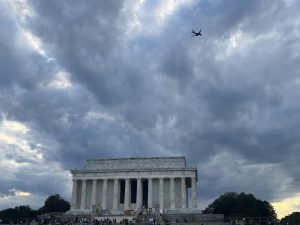
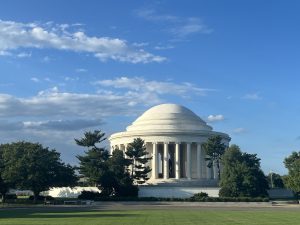
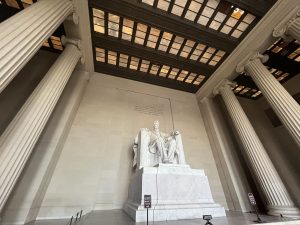
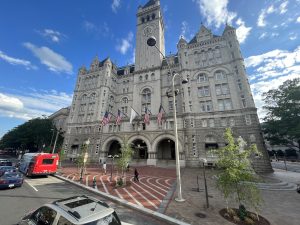
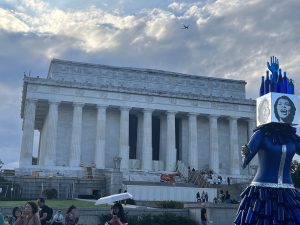
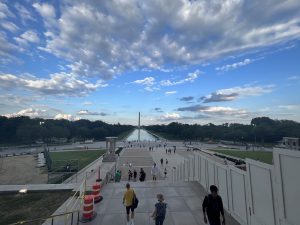
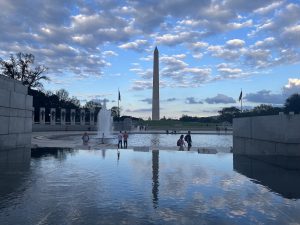
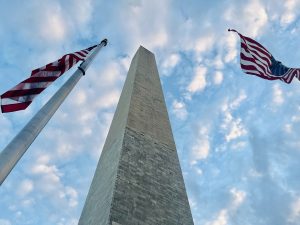
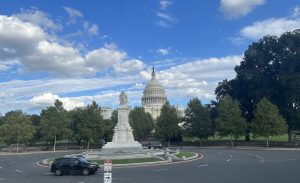
Image9: The Capitol Hill is the seat of the U.S. government, home to the domed United States Capitol, Senate, Houses of Representatives and the neoclassical Supreme Court..
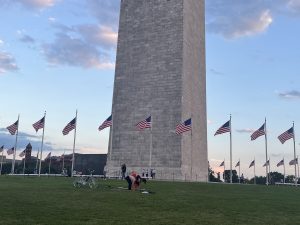
Image10: Flags encircling the Washington Monument.
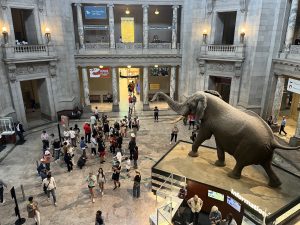
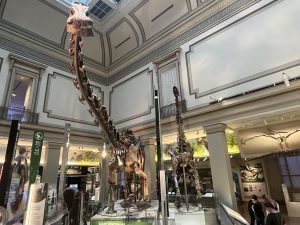
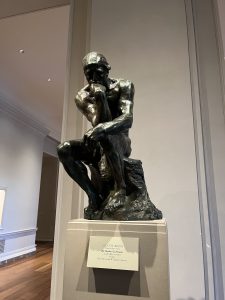
Image13: Diplodocus is among the most easily identifiable dinosaurs, with its typical sauropod shape, long neck and tail, and four sturdy legs. The fossils of the dinosaur were discovered in 1877.
